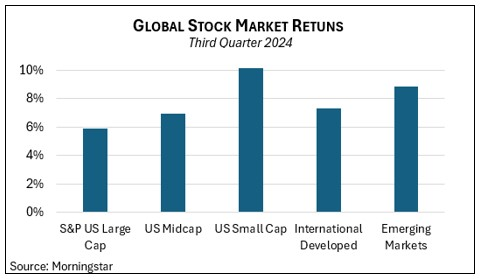We hope this quarterly note finds you well.
The Irrepressible Stock Market
Global stock markets vaulted upward yet again in the third quarter. The S&P 500 US large cap benchmark returned almost 6% and, for a change, US midcap and small cap, international developed, and emerging markets stocks did even better. The S&P 500 closed the quarter up about 22% year to date, matching its 2023 return and bringing its return since the start of last year to nearly 50%. This works out to a 25.5% compound annual rate of return over the last 21 months, which is great but also unsustainable. Over the past century, the US market has averaged just north of 10% per year, a number that many consider optimistic today, with stocks expensive by historical standards.

In September, the Federal Reserve made its long-awaited easing, a hefty 0.50% reduction in short-term interest rates. Combined with continued steady growth in both the economy and corporate profits, investors celebrated by bidding up stock prices worldwide. The S&P 500 and the venerable Dow Jones Industrial Average both hit record highs in September.
Bonds joined the party in the third quarter, with the main US bond index leaping just over 5% and nearly matching the S&P 500. (Declining interest rates push up the price of existing bonds.) The result was a heady quarter for investors across the risk spectrum, with both stocks and bonds shining. For a fuller discussion of the past quarter, be sure to see our Economic and Market Review that accompanies this letter.
Keeping Our Heads
Normally this phrase (from Kipling’s famous poem “If”) refers to difficult times and the challenge of maintaining one’s equilibrium amid turbulence. But for investors, we think the concept equally applies to the best of times, which describes the stock market for most of the last fifteen years and especially 2023 and 2024.
When stocks race higher, there is a natural tendency to expect the trend to continue. It goes against our gut to sell stocks in a rising market. If anything, the apparent uptrend makes investors want to allocate more to stocks. This is the “greed” half of the fear-and-greed cycle.
To keep our heads (and yours), we regularly rebalance portfolios, selling some of the assets that have risen most (lately, that’s stocks), bringing the asset allocation back within a range that reflects our understanding of the client’s tolerance for risk. This discipline is important. When the inevitable market downturn arrives, we want clients in a position that enables them to ride out the storm, rather than having to abandon ship because their portfolio inadvertently became too risky.
For a fuller discussion, be sure to see our Q3 Economic & Market Review.

